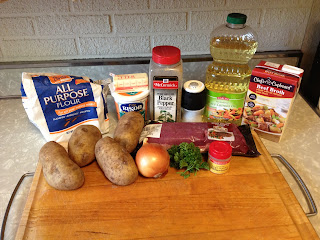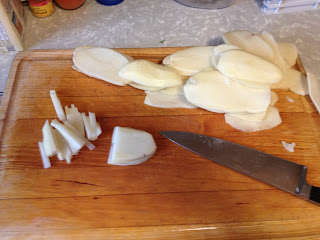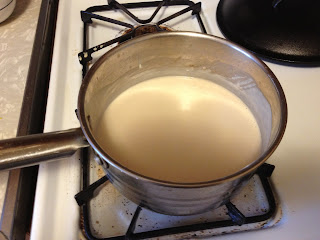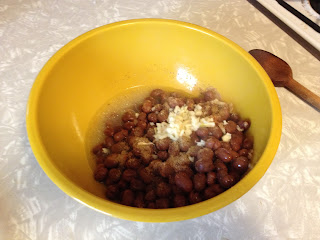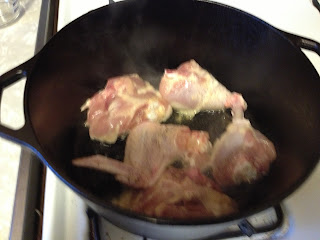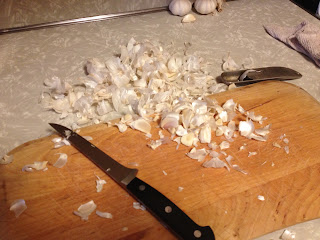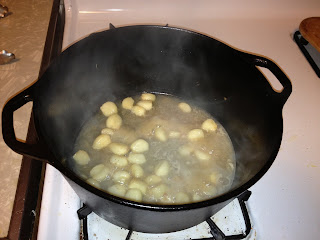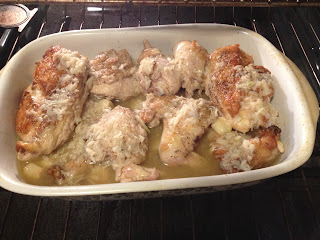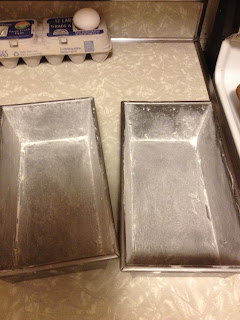Growing up, everyone has certain food or dishes that become staples in the family menu and get passed on from generation to generation. In the Schuler household we had several. Rice Ole, Creamed Chipped Beef on Toast, Turkey Casserole with Cranberry Pinwheels and of course, the creamy, beefy, noodle-y masterpiece, Beef Stroganoff. The version that we enjoyed in our family consisted of hamburger, onion, mushrooms and sour cream cooked up and served over buttered noodles. When I first saw "Stroganoff" on the list, I was excited, but this version is bit different than the one I grew up on, substituting matchstick potatoes for noodles, beef tenderloin for hamburger and without mushrooms.
The ingredients for this version of the recipe are:
4 tbsp. unsalted butter
2 tbsp. flour
1 tsp. dry mustard
1 cup beef stock
1/4 cup sour cream
1 small yellow onion, thinly sliced
11/2 lb beef tenderloin, cut into 3" x 1" x 1/2" slices
Kosher Salt and fresh ground pepper to taste
Canola oil, for frying
4 russet potatoes, peeled and sliced into 1/8" matchsticks
2 tbsp. finely chopped parsley.
As with many recipes, in order to get the dish done properly, you have to be able to multitask efficiently. You must create a roux and the sauce; peel, slice and fry the potatoes, cook the beef and onions and then bring everything together. Usually not a big issue for me, but through in taking notes and pictures...and we have a party!
First on the agenda was to peel, slice chop the potatoes into matchstick potatoes. After chopping them, I put them between paper towels to draw out a bit of the excess moisture. A trick to crispy matchstick fries is to make sure they are as dry as possible, and placing them into oil that is properly heated. I poured the oil to a depth of about 1 1/2" in a dutch over and heated to 375 degrees. Working in batches I fried the potatoes up until they were golden and crisp (about 5 minutes). It took me a batch or two to figure the right amount of potatoes to put in at once (about a cup and a half) as when you put too many into the oil at once, they drop the temperature of the oil down faster than the burner can heat it, not only slowing down cooking, but slowing the frying process, resulting in a greasy fry. When the potatoes were done cooking I removed them with a metal slotted spoon and placed them on paper towels to drain, then sprinkled them with kosher salt.
While the potatoes were frying up, I took 1/2 of the butter and melted it in a saucepan and added the flour and dry mustard, cooking for about two minutes. If you like a nutty flavor to your sauces, continue cooking the roux (flour and butter mixture) for another 30 seconds to a minute and it will start to brown a bit. I then added the chicken stock slowly, whisking constantly. I brought that (basically chicken gravy) to a boil and cooked until it thickened a bit, and mixed in the sour cream. Once the sour cream was fully incorporated, I took it off the heat and set it aside.
With the sauce under control, I sliced the onions and sauteed them in the remaining butter until soft and a bit caramelized (about 6 minutes). With the onions underway, I sliced the beef and placed it in the pan, cooking until the bits were cooked to about medium. When you make stroganoff with hamburger, you have to cook it completely, but with the beef, I figured that it would continue cooking in the sauce for a bit and I wanted to make sure that it was cooked enough to eliminate the blood that may still be in the meat, but keep it from overcooking in the sauce and make it tough and stringy.
When the meat was cooked, I emptied the saucepan into the skillet and brought it back up just below a boil. I plated the dish by placing the beef and sauce mixture on the plate, setting a handful of potatoes on top of it and then sprinkling with parsley.
I had the same problem with this stroganoff that I had with the version that my mother made, I couldn't get enough! The meat turned out just right, tender and moist. The sauce had that fantastic sour cream tang, but deeper flavors thanks to the onion and dry mustard. The potatoes were OK, but in a next round, I would slice the matchsticks smaller. Mine ended up being more like fries than matchsticks (see pic above). I still prefer noodles though. I did miss the mushrooms, which would be easy enough to add into the recipe.
 |
| Credit: Todd Coleman |
My dining companions (Kim and my sister Brooke) were big fans of the meal. Enough that we had no leftovers. They enjoyed the flavor and Kim was especially happy to not have to pick out mushrooms from her dinner.
Another recipe in the books, and again, a recipe that I will make in some form again in future. Next on the list - my first ever attempt at Indian Cuisine - Saag Paneer. Should be interesting!
8 down, 93 to go.
